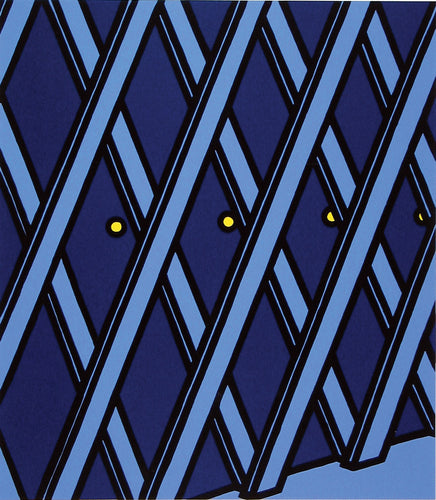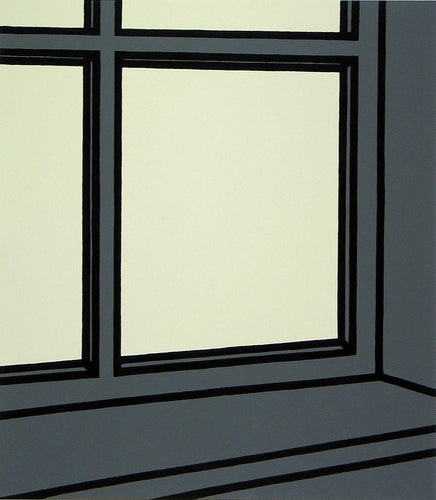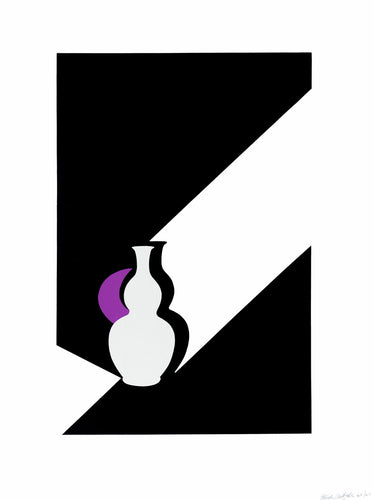No artist of his generation has contemplated the comedy of life with greater intelligence, wit or courage than Patrick Caulfield. – art critic Mel Gooding
For the oblique work of Patrick Caulfield, the ‘Pop-Art’ label was a predictable misnomer. While in its flat planes of colour, its bold, black outlines, and the underlying influence of commercial graphics it typified much of that movement’s recognisable style, in subject matter Caulfield took the cynical flavour of ‘pop’ in an entirely new poetic direction.
 Oh Helen, I Roam My Room
Oh Helen, I Roam My Room
Born in London in 1936, like his father Caulfield left school at 15 to work in a factory before securing brief employment in the advertising department of the food producers Crosse and Blackwell. Though his time at the company was short (Caulfield enlisted early in the RAF, knowing he would be called up for mandatory National Service), it offered his first taste of the world of graphic design: of inks and varnish, stylised compositions, and the company of mature artists.

 (above) Large White Jug (left) and Vessel (right); (below) Large Jug
(above) Large White Jug (left) and Vessel (right); (below) Large Jug
Something of the experience rubbed off on the young Caulfield. Declining the possibility of overseas posts in exotic new countries, he instead stayed in London throughout his enrolment in the air force, taking up evening classes in life drawing and portraiture and spending his free time visiting his first exhibitions before applying to study at the local Chelsea School of Art and, later, the Royal College of Art.
 Lobster
Lobster
It was here as a student of the early 1960s, famously a year below David Hockney and R. B. Kitaj, that Caulfield first developed his distinctive style. While contemporaries looked to America, to New York’s Abstract Expressionists and the satirical gloss of Warhol and the Factory, Caulfield sought order, formalism, and a visual language that reduced objects and scenes to their most essential modes. Above all other sources of inspiration, he found an early hero in the Spanish Cubist Juan Gris: What I like about [his] work is not that he’s dealing with different viewpoints, it’s the way he does it. It’s very strong, formally, and decorative… His paintings architecturally are so strong, without feelings of doubt.
 Red and White Still Life
Red and White Still Life
Channeling the certainty, if not the style, of Gris’ work, Caulfield’s first still lifes and interiors were reproduced in linear black silhouettes, each caged outline locking in blocks of pungent colour offset against neighbouring subjects. The execution of each image seemed underpinned by techniques observed in those early days varnishing chocolate advertisements at Blackwell’s and which were developed in his first terms at the Royal College, where Caulfield began in the Visual Design department before transferring, on the strength of his painting, to the Fine Arts.

 Letter (above) and Occasional Table (below)
Letter (above) and Occasional Table (below)
By the mid-1960s, and now a graduate, Caulfield’s individual approach to composition was beginning to attract gallerists and collectors alike. He took part in his first major exhibition at the Whitechapel in ’64 alongside fellow rising stars including Hockney, John Hoyland, and Bridget Riley, with a first solo show following a few months later. Significantly, this was also the year of his first print, the screenprint Ruins, produced at the renowned Kelpra Studio in collaboration with Chris Prater. Over the years Caulfield would enjoy a long and productive relationship with Prater, thought by many of the artists he worked with to have been the greatest technician of his generation.
 My Life Inspires So Many Desires!
My Life Inspires So Many Desires!
The silkscreen process and its rich, flat surface quality naturally lent itself to Caulfield’s imagery. Between its clarity of shapes and lines and the comparative ambivalence of his compositions – empty chairs, window frames, and abandoned tables – Caulfield combined melancholy and tension to powerful effect in the medium, capturing the unending stillness that pervades much of our everyday living and portraying it in lurid colour as if to heighten the mundane to the vibrant.
 (left) Ah! This Life Is So Everyday; (right) Watch Me Eat, Without Appetite, A La Carte
(left) Ah! This Life Is So Everyday; (right) Watch Me Eat, Without Appetite, A La Carte
Nowhere was this dichotomy more clearly felt than in the momentous ‘Laforgue’ suite, a limited edition livre d’artiste commissioned and published by the Petersburg Press and inspired by the free verse of the 19th century modernist poet Jules Laforgue. Caulfield explores Laforgue’s words as if he were a jaded Hergé describing in ligne claire the backdrop of a Raymond Carver short story: a tooth-jangling lemon yellow clock still ticks away the dull hours; the monotony of a kitchen cupboard, punctured by two cyan handles, throbs in crimson red.
 We Wanted To Bleed The Silence
We Wanted To Bleed The Silence
As he headed into the latter half of his career, Caulfield was confident enough in his painted and printed spaces to leave behind the now ubiquitous black outline. Light alone was necessary to enable the viewer to see each interior, deflected across a room to reveal dusky hints of objects within and suggest the slightest of perspectives. Edward Hopper, an artist for whom light, shadow, and distance were key compositional elements, had remained a favourite of Caulfield’s since the early 1950s. By the 1990 White Ware Prints series, illuminated throughout in minimalist whites and midnight blues, browns and blacks, Caulfield had taken the application of light and advanced it to its extremes.
 (left) Arita Flask; (right) Lung Chu'an Ware and Window
(left) Arita Flask; (right) Lung Chu'an Ware and Window
Though Caulfield’s art remained ‘figurative’ throughout his career, figures themselves are conspicuously missing from many of his images. Instead, his work hinged on the suggestion of absent people: cigarette stubs on a tiled floor; rays of light between vases and tasseled lampshades, intruding through the curtains of an unoccupied room. The omission was conscious and deliberate: It seemed to me that Picasso had pulled the plug on interpreting the human form… You can’t actually deal with the figure like that any more, except in an expressionist sense.
 And I Am Alone In My House
And I Am Alone In My House
In Caulfield’s art, the lights are on, the table set, yet no one is there. The effect can be disconcerting: through manipulations of depth and perspective, and in the absence of a subject, it is the viewer who takes their place in these empty vignettes, as if inserted into the image itself. This was the power of those early prints and paintings, and which sustained Caulfield’s haunting work throughout his career: the ability to transport us into each strange and closed-off world he created.

 (above) Highlights (left) and Stones (right); Screen (below, all from Wall Plates series)
(above) Highlights (left) and Stones (right); Screen (below, all from Wall Plates series)
Since his death in 2005, Caulfield’s legacy - somewhat overshadowed during his time by the weight of contemporary personalities – has attracted serious critical attention, culminating in a recent retrospective at the Tate in 2013. Given the uniqueness of his work, its peculiar balances between light and shade, distinction and dispassion, the implicit voyeur and the explicit room, such interest should come as no surprise.










